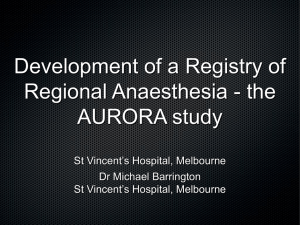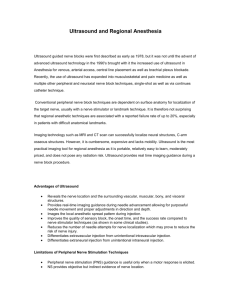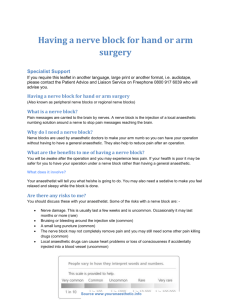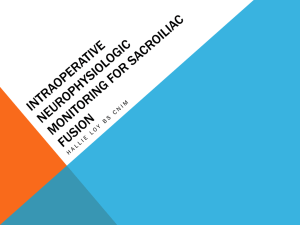Procedure-specific peripheral nerve blocks - ADAM
advertisement
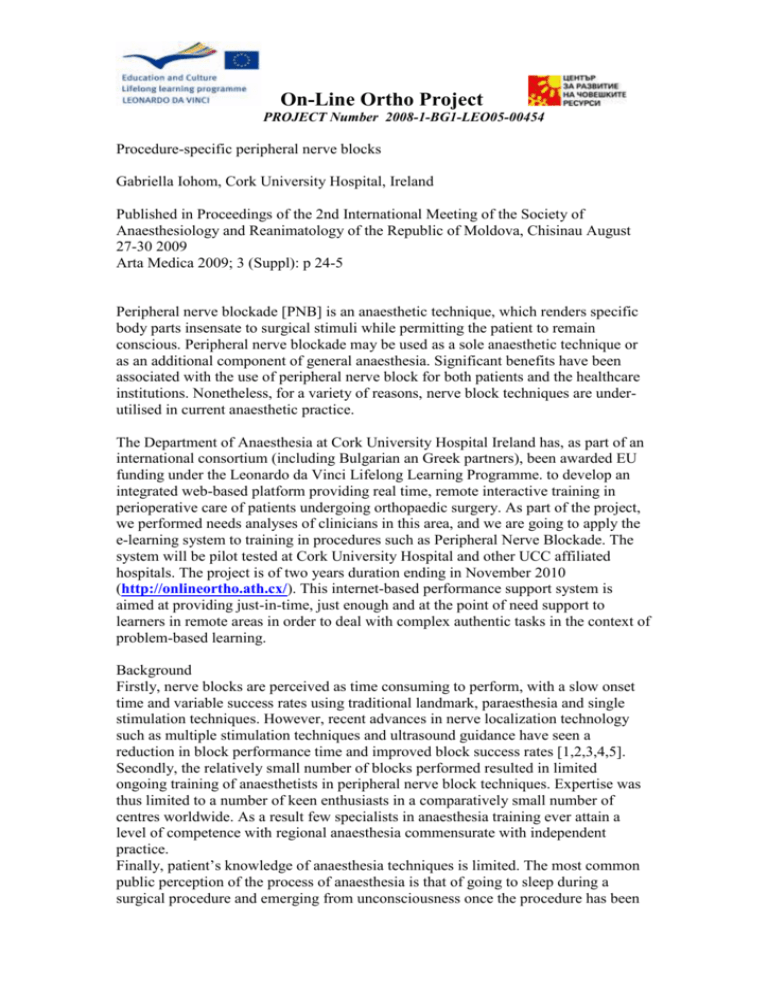
On-Line Ortho Project PROJECT Number 2008-1-BG1-LEO05-00454 Procedure-specific peripheral nerve blocks Gabriella Iohom, Cork University Hospital, Ireland Published in Proceedings of the 2nd International Meeting of the Society of Anaesthesiology and Reanimatology of the Republic of Moldova, Chisinau August 27-30 2009 Arta Medica 2009; 3 (Suppl): p 24-5 Peripheral nerve blockade [PNB] is an anaesthetic technique, which renders specific body parts insensate to surgical stimuli while permitting the patient to remain conscious. Peripheral nerve blockade may be used as a sole anaesthetic technique or as an additional component of general anaesthesia. Significant benefits have been associated with the use of peripheral nerve block for both patients and the healthcare institutions. Nonetheless, for a variety of reasons, nerve block techniques are underutilised in current anaesthetic practice. The Department of Anaesthesia at Cork University Hospital Ireland has, as part of an international consortium (including Bulgarian an Greek partners), been awarded EU funding under the Leonardo da Vinci Lifelong Learning Programme. to develop an integrated web-based platform providing real time, remote interactive training in perioperative care of patients undergoing orthopaedic surgery. As part of the project, we performed needs analyses of clinicians in this area, and we are going to apply the e-learning system to training in procedures such as Peripheral Nerve Blockade. The system will be pilot tested at Cork University Hospital and other UCC affiliated hospitals. The project is of two years duration ending in November 2010 (http://onlineortho.ath.cx/). This internet-based performance support system is aimed at providing just-in-time, just enough and at the point of need support to learners in remote areas in order to deal with complex authentic tasks in the context of problem-based learning. Background Firstly, nerve blocks are perceived as time consuming to perform, with a slow onset time and variable success rates using traditional landmark, paraesthesia and single stimulation techniques. However, recent advances in nerve localization technology such as multiple stimulation techniques and ultrasound guidance have seen a reduction in block performance time and improved block success rates [1,2,3,4,5]. Secondly, the relatively small number of blocks performed resulted in limited ongoing training of anaesthetists in peripheral nerve block techniques. Expertise was thus limited to a number of keen enthusiasts in a comparatively small number of centres worldwide. As a result few specialists in anaesthesia training ever attain a level of competence with regional anaesthesia commensurate with independent practice. Finally, patient’s knowledge of anaesthesia techniques is limited. The most common public perception of the process of anaesthesia is that of going to sleep during a surgical procedure and emerging from unconsciousness once the procedure has been On-Line Ortho Project PROJECT Number 2008-1-BG1-LEO05-00454 completed. Patient anxieties and attitudes toward regional anaesthesia focus on fears such as paralysis and permanent disability, which limit the practice of regional anaesthesia [6]. Studies report that less than 25% of those surveyed, understood correctly the process of anaesthesia, most believing that anaesthesia was merely a state of unconsciousness [7,8,9]. Similarly less than 25% of people were aware that anaesthetists were physicians with specialist training [7]. One study reported that 35% believed anaesthetists had no medical qualifications [8]. Therefore, published research suggests that a significant knowledge deficit exists amongst patients and that fears regarding the use of regional anesthesia (peripheral nerve block) should be addressed. It is evident that the practice of peripheral nerve block faces multiple barriers from the perspective of technical skills, surgical acceptance and most importantly patient acceptance. Needs analysis Our need analysis within the On-line Ortho project sought to identify the learning needs of patients, surgeons, anaesthetists and other peri-operative healthcare workers specifically related to peripheral nerve blockade. Patient awareness and acceptance of PNB is essential. The patient survey highlights a knowledge deficit amongst patients with regard to the potential advantages of PNB. Patient expectations centre on the provision of general anaesthesia, while most surveyed indicated willingness to accept PNB if appropriate information were provided prior to surgery. A structured and timely anaesthesia preoperative visit may improve the uptake of PNB. The surgeon, as the most common patient information source, has an important role to play. The novelty of the PNB component of the On-line Ortho project lies with its procedure-specificity. Each surgical procedure will have links to suitable PNB techniques, with preference for distal ones. Thus, surgeons will also be informed as to the most suitable PNB techniques for each procedure. Anaesthetists will not only find just-in-time, just-enough and at the point of need information on PNB suitable for individual procedures, but learning will be enhanced by clinical demonstrations. The format should not just be a reproduction of a textbook, but rather centred on problem-based learning. By increasing the block success rate, PNB may become widely accepted by patients, surgeons and theatre staff. Peripheral nerve blockade has proven benefits. By addressing the training requirements of medical staff more patients could benefit from these evidence-based improved outcomes. Procedure-specificity It is defined by an adequate block with the least undesirable insensate limb [10] or loss of motor function. Recommendations take into account the results of the need analysis, rely on existing evidence for recommending certain blocks for certain procedures, and use repeated focus groups to make suggestions through personal experience and consensus where evidence is lacking. Principles underlying the choice of appropriate blocks include: knowledge of the area/depth of surgery, the use of tourniquet and the ambulatory nature of the On-Line Ortho Project PROJECT Number 2008-1-BG1-LEO05-00454 procedure [15]. The anaesthetists’ armamentarium consists of a range of local anaesthetics and a specific block/combination of blocks. Successful nerve blocks depend on correct peri-neural needle and local anaesthetic injectate placement. Nerve stimulators are worldwide the most frequently used method of nerve localization for peripheral nerve block. Motor stimulus is usually obtained by delivery of current at a frequency of 2Hz and a pulse duration of 0.1 ms. The minimum stimulation threshold for peripheral nerves in humans is variable. It is generally accepted that motor stimulus between 0.3 and 0.5 mA at 0.1ms is a safe and effective nerve stimulation endpoint. It is important that the nerve stimulation criteria alone are not used in isolation to confirm correct peri-neural needle placement. Suggested added criteria include the aforementioned stimulation parameters delivered via an unrestrained and immobile needle, the sensation of penetrating the relevant fascia, a clear motor end point (e.g. flexion of medial 3 fingers at 0.3mA at 0.1ms for the median nerve), the disappearance of a muscular contraction following the injection of 1mL of local anesthetic solution (Raj Test), and painless injection without resistance [14]. A multi-stimulation technique where possible, provides greater block success than a single stimulation technique. Another related advancement in the field (outside the scope of this synopsis) is progressive dose-reduction as a result of accurate LA injectate placement [16, 17]. Examples: Carpal tunnel surgery may be performed under local anaesthesia, median at elbow plus ulnar at wrist using a forearm tourniquet, mid-humeral block using a short acting local anaesthetic (LA) on the radial and musculocutaneous and a long acting LA on the median and ulnar components [11] or under an axillary block. Block assessment is carried out following the performance of the block. Each nerve territory is examined separately for both motor and sensory block. Incomplete blocks may be supplemented if necessary (at a more distal level or by local infiltration at the surgical site) A radiocephalic arterio-venous fistula may be peformed under a conventional axillary block, but also under a combination of specific radial and musculocutaneous blocks at mid-humeral level [12]. A femoral or iliacus block may be part of multimodal analgesia for hip or knee surgery. By adding an obturator block, analgesia for knee surgery is markedly improved [13]. For complete anaesthesia of the knee, of course, all terminal branches of the lumbar (femoral and obturator nerves) and sacral plexi (sciatic nerve) need to be blocked. This could be achieved using a psoas compartment + parasacral or more distal approaches. All foot surgery may adequately be carried out under a combination of propliteal and femoral block using a calf tourniquet. On-Line Ortho Project PROJECT Number 2008-1-BG1-LEO05-00454 In conclusion, each clinical scenario is best managed by using the evidence-based judgement and procedural skill of the attending anaesthetist. On-Line Ortho Project PROJECT Number 2008-1-BG1-LEO05-00454 References 1. Chan VW, Perlas A, McCartney CJ, Brull R, Xu D, Abbas S: Ultrasound guidance improves success rate of axillary brachial plexus block. Can J Anaesth 2007; 54:176-82 2. Williams SR, Chouinard P, Arcand G, Harris P, Ruel M, Boudreault D, Girard F. Ultrasound guidance speeds execution and improves the quality of supraclavicular block. Anesth Analg. 2003; 97:1518-23. 3. Marhofer P, Schrogendorfer K, Koinig H, Kapral S, Weinstabl C, Mayer N. Ultrasonographic guidance improves sensory block and onset time of three-inone blocks. Anesth Analg 1997; 85: 854–7. 4. Kapral S, Greher M, Huber G, Willschke H, Kettner S, Kdolsky R, Marhofer P. Ultrasonographic guidance improves the success rate of interscalene brachial plexus blockade. Reg Anesth Pain Med 2008;33: 253-8. 5. Rodriguez J, Taboada M, Del Rio S, Barcena M, Alvarez J. A comparison of four simulation patterns in axillary block. Reg Anesth Pain Med 2005; 30: 324-8. 6. Matthey PW; Finegan BA; Finucane BT. The publics fears and perceptions about regional anesthesia. Reg Anesth Pain Med 2004; 29: 96-101. 7. Swinhoe CF, Groves ER. Patients Knowledge of anaesthetic practice and the role of anaesthetists. Anaesthesia 1994; 49: 165-6. 8. Tanser SJ, Birt DJ. Whos watching over me? Was the publics’ perception of the anaesthetist changed by National Anaesthesia Day. J R Nav Med Serv 2000; 86: 134-41. 9. Chew ST, Tan T, Tan SS, Ip-Yam IP. A survey of patient’s knowledge of anesthesia and peri-operative care. Singapore Med J 1998; 39: 399-402. 10. Ilfeld BM, Ramjohn J, Loland VJ, et al. The effects of local anesthetic concentration and dose on continuous infraclavicular nerve blocks: a multicenter, randomized, observer-masked, controlled study. Anesth Analg 2009; 108: 345-50. 11. Bouaziz H, Narchi P, Mercier FJ, et al. The use of selective axillary nerve block for outpatient hand surgery. Anesth Analg 1998; 86: 746-8. 12. Yazigi A, El-Khoury C, Jebara S, et al. Selective radial and musculocutaneous nerve block at midhumeral level for radiocephalic arteriovenous fistula construction. Anaesth Intensive Care 2007; 35: 447-8. 13. Macalou D, Trueck S, Meuret P, et al. Postoperative analgesia after total knee replacement: the effect of an obturator nerve block added to the femoral 3-in-1 nerve block. Anesth Analg. 2004; 99: 251-4. 14. Jochum D, Iohom G, Diarra DP. An objective assessment of nerve stimulators used for peripheral nerve blockade. Anaesthesia 2006; 61: 557-64. 15. O’Donnell BD, Iohom G. Regional anesthesia techniques for ambulatory orthopedic surgery. Curr Opin Anaesthesiol 2008; 21: 723-8. 16. O’Donnell BD, Ryan H, O’Sullivan O, Iohom G. Ultrasound-guided axillary brachial plexus block with 20 milliliters local anesthetic mixture versus general anesthesia for upper limb trauma surgery: an observer-blinded, prospective, randomized, controlled trial. Anesth Analg. 2009;109: 279-83. On-Line Ortho Project PROJECT Number 2008-1-BG1-LEO05-00454 17. O’Donnell BD, Iohom G. An estimation of the minimum effective anesthetic volume of 2% lidocaine in ultrasound-guided axillary brachial plexus block. Anesthesiology. 2009; 111: 25-9.


